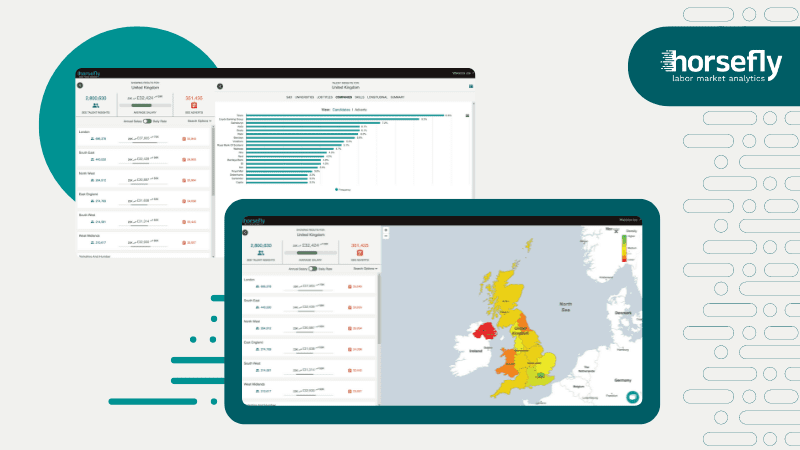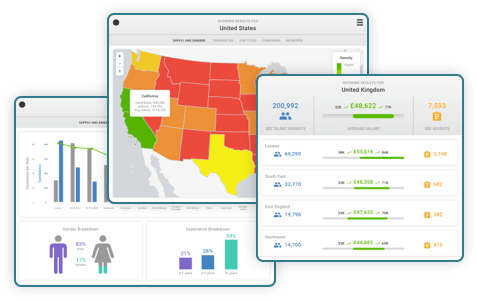Attract Top Talent:
How Compensation Benchmarking Tools Can Improve Your Hiring Strategy
Compensation benchmarking could be the ultimate solution to your hiring problems.
Updated 8th July 2025

In a skills-short landscape, attracting and retaining the most valuable professionals for your team can be much harder than it seems.
In fact, 49% of employers today say they’re concerned they don't have workers with the right skills.
While a great salary and compensation package won’t guarantee you’ll always capture the attention of the most talented professionals, it does make a significant difference. No employee will choose to work for your organization if they feel they’re not being offered a fair or competitive wage.
Even if you offer amazing work-life balance, and a fantastic company culture – the best employees will always want to feel as though they’re being paid what they’re worth.
With compensation benchmarking tools, you can improve your chances of attracting the top talent in your industry and even reduce the risk of your existing employees jumping ship in search of more competitive salaries.
Let’s take a closer look at how compensation benchmarking tools can enhance your hiring strategy.
What Is Compensation Benchmarking
Compensation benchmarking, or salary benchmarking, is the process of comparing the wages, benefits, and remuneration you offer employees in a role to the compensation other companies offer employees with the same position.
The purpose is to determine whether your salary range falls into the average for the jobs you’re trying to fill.
When benchmarking compensation and salaries, HR departments and business leaders often need to consider a number of factors, including a company’s size, industry, and location.
Additionally, it’s important to consider the unique nuances of the position, such as what kind of training is offered on the job, what education is necessary for the employee to get the role, and so on.
By benchmarking salaries, companies can ensure they choose competitive salary scales for their open roles, making them more likely to attract talented professionals and candidates. Effective salary benchmarking can also help to preserve a company’s reputation.
After all, only 7 out of 10 people believe that they feel they’re being paid fair wages.
Those who feel their salary isn’t competitive enough are less likely to be loyal to their employers and more likely to feel negatively about the companies and brands they work for.
The Benefits of Compensation Benchmarking Tools
Ultimately, using a compensation benchmarking tool is a way for companies to ensure they remain competitive in the war for talent. Gathering labor market intelligence ensures organizations can choose salaries that attract top talent, keep employees from leaving the business, and enhance their reputation.
- Successfully Attract Top Talent (Even in a Skills-short Market)
51% of companies say offering competitive or above-average salaries is a top priority when looking to attract or retain top talent. - Build a Stronger Team
Offering the right salary to professionals in your industry means you’re more likely to attract experienced, educated individuals to your team. You can therefore make smarter hires and avoid simply settling for whoever accepts your offer. - Improve Their Reputation
Salary benchmarking ensures you can stay up to date with the industry standards and trends in your landscape. This means you stay relevant and authoritative and preserve your positive reputation among potential candidates. - Boost Efficiency
Compensation benchmarking tools can help companies to optimize their hiring process. You can use it to avoid wasting time and resources on hires that aren’t a good fit for the company, and you may even be able to avoid overpaying employees in certain roles. - Maintain Compliance
In some cases, compensation benchmarking can also help businesses to ensure their hiring strategy is compliant with local, federal, and state laws. It ensures you’re not paying employees too little, which could lead to costly fines and other issues.

Smarter & More-informed Hiring Strategies
Unlock Accurate Labor Market Data With Horsefly
With Horsefly, you can leverage our comprehensive labor market data to identify and connect with the right talent for your organization, even when dealing with these more niche pain points. Horsefly helps with:
Difficulty in Identifying Top Talent
A study shows that employers who select the top 20% of candidates experience 30% higher profitability. However, identifying top talent has always been a challenge for businesses. With labor analytics software, companies can quickly scan through a large pool of applications and identify the best candidates with the right skill set and experience.
Staying Within Budget Restrictions
Hiring in-demand candidates can be expensive, and companies need to be able to do so while staying within budget restrictions. Labor analytics software can help by providing insights into the cost of hiring and identifying ways to reduce those costs. Horsefly can help identify candidates with the most in-demand skills within the company's budget, saving both time and money.
Addressing Current and Future Skill Gaps
Companies need to be able to identify current and future skill gaps to enable effective workforce planning. Labor analytics software can provide insights into the skills required for the workforce of the future, ensuring that companies remain ahead of the curve.

How Does Salary Benchmarking Work?
In the past, Human Resources teams had to spend significant time and effort gathering compensation data for a benchmarking strategy. However, these days, it’s often much easier to benchmark salaries, thanks to dynamic platforms like Horsefly Analytics.
Using the talent acquisition analytics tools from Horsefly, companies can instantly access valuable, global market data to help them make smarter, more strategic hiring decisions.
Companies can use Horsefly Analytics to update their compensation strategy in seconds by searching for job title information in their region, industry, or location. By drilling down into the available market data, HR professionals can quickly define which salary ranges will be the most competitive for each role.
Countless leading companies have already begun to leverage the benefits of compensation benchmarking themselves.
For instance, Nationwide Building Society, one of the world’s largest financial institutions, utilized Horsefly Analytics as part of a large IT transformation project.
The brand knew it needed to bring new talented team members on board to enable the expansion and wanted to ensure it was accessing the right skills and expertise for rapid growth.
Turning to the Horsefly Analytics system, Nationwide was able to map the talent landscape across 12 specific locations within the UK.
They developed a deeper understanding of not just the salary and compensation expectations of their candidates but which technical skills they needed to prioritize.
3 Tips for Implementing Compensation Benchmarking Tools
The evolution of the digital world and the introduction of new tools for analysis and evaluation has opened the door to a more streamlined compensation benchmarking process for most brands.
Today’s companies don’t need to spend days tracking and curating salary data every time they want to bring a new employee on board.
A dynamic benchmarking tool can streamline the process and reduce the risk of errors.
However, there are still some tips companies will need to keep in mind to boost their chances of success:
1
Find the Right Data Sources
The data you use for benchmarking employee compensation needs to be accurate and relevant. When leveraging a benchmarking tool, make sure you’re looking only at the data that aligns with your job descriptions, locations, and industry.
Consider the value of the data by assessing its completeness, age, and accuracy. Remember, some data may be less reliable than you’d think. That’s why it’s always important to work with a reputable analytics company when sourcing insights.
2
Understand Compliance Risks
Make sure you know what the minimum wage is in your location, and work with a legal expert if you’re not sure whether you’ll have other rules and regulations to adhere to. Don’t make the mistake of assuming you can offer a lower compensation rate than you expected just because your data suggests this.
3
Apply Compensation Strategies Carefully
Once you’ve assessed your available data and examined the compliance landscape, start working on some salary ranges. Creating fixed salary ranges can help you to predict salary costs while ensuring your hiring strategy remains competitive.
Remember, offering a low salary, even if it’s line with the average for your location or industry, might not be the best way to attract the best talent. Be willing to experiment with your compensation strategy.
Embrace Compensation Benchmarking
Building a strategy for compensation benchmarking around accurate, insightful data sources ensures you can improve your chances of attracting and retaining the right candidates for your team.
At a time when it’s becoming increasingly difficult for even the best companies to fill talent gaps, using a compensation benchmarking tool to get your employee compensation plan right is crucial. Just remember, the best benchmarking strategies start with the right data. If your data resources aren’t accurate, you won’t be able to get a clear view of the market. Horsefly Analytics has already proved itself to be a reputable solution for companies in search of an efficient and streamlined benchmarking strategy.
Discover what Horsefly can do for your organization with our state-of-the-art software today.
.png?width=2000&name=Horsefly-Logo-NewTag_White%20(3).png)